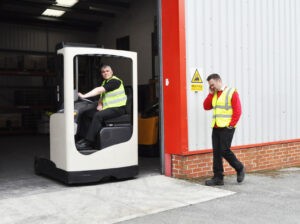FORKLIFT SAFETY
Creating safer forklift truck operations
Stuart Taylor of Mentor FLT Training explains why those working alongside forklift trucks should understand the risks to help keep themselves and others safe.
According to RIDDOR figures from recent years, 43% of incidents involving a forklift truck were impacts with a third person. These include pedestrians engaged in unrelated activities, co-workers, supervisors and delivery drivers. Only recently a company in Blackpool was fined £40,000 after a worker was struck by a forklift.
 Unlike operator training, awareness training for those working alongside Materials Handling Equipment (MHE) is often overlooked, and yet, these individuals are the most vulnerable. While the operator is protected by the truck’s cab, pedestrians are exposed and most likely to sustain a serious injury, should something go wrong.
Unlike operator training, awareness training for those working alongside Materials Handling Equipment (MHE) is often overlooked, and yet, these individuals are the most vulnerable. While the operator is protected by the truck’s cab, pedestrians are exposed and most likely to sustain a serious injury, should something go wrong.
Remember, when we refer to pedestrians, we don’t just mean colleagues who work in the area. It includes visitors, delivery drivers, staff members from other areas of the company and even forklift drivers themselves, once they have dismounted from their trucks. Anyone who may find themselves in the vicinity of MHE is at risk.
Ultimately, it is the responsibility of forklift operators (and their manager/employers) to ensure forklifts are used safely on-site. Ensuring that measures such as operator training, safe systems of work and regular monitoring are in place will undoubtedly help to create safer operations.
But further improvements can be made by providing basic awareness to those most at risk and preparing all staff to handle potentially dangerous scenarios safely. Real gains can come from ensuring that everyone working in the vicinity of MHE understands what to do – and what not to do – to keep themselves and others safe.
What steps can pedestrians take?
- Use pedestrian walkways/zones: One of the biggest risks to safety on a site with forklifts operating is inadequate segregation between trucks and pedestrians. Forklifts and people on foot should be separated, wherever possible, ideally by physical segregation using barriers, designated zones and separate traffic routes to keep them apart. Where walkways are available, they should be used – every time.
- Stick to safe systems of work: Where total separation is not feasible and staff are required to perform tasks in a shared area, there should be other control measures in place to keep them apart. Safe systems of work (SSOW) – based on risk assessments of specific tasks – will ensure that all parties understand how to carry out their duties safely. These should be communicated to all who may be affected and must be followed day in, day out.
- Keep a safe distance from MHE: While this should be a regular theme in a company’s SSOW, it is general fundamental principle which everyone should understand and follow throughout their time on site to reduce risk. Sadly, many injuries occur when pedestrians find themselves too close to forklift trucks when they do not need to be there in the first place. When establishing what constitutes a safe distance, consider the specific nature of the operation, e.g. if a forklift is unloading from height, leave more distance as, in the event of a tip over, the area covered by the falling mast and load will be larger.
- Wear PPE: Pedestrians must wear any PPE issued to them by their employer for their safety, such as high-vis jackets and safety boots. Not only is this good practice, it is also a legal requirement upon the employee.
- Follow signage: Posters and signs will likely be positioned around site, to reinforce safety measures and travel routes. Take note of these and follow the guidance at all times.
- Report bad practice: Staff must be mindful not only for their own safety, but also that of their peers, and while managers have an obligation to monitor behaviour, there may be times when it is necessary for a staff member to flag the actions of others. Unsafe forklift operation or disregard for safe travel routes are examples of bad practice that should be reported to a supervisor for the safety of everyone on site.
Training for all
It’s important that everyone at risk understands the importance of following safety measures, and the potential consequences if they don’t. By increasing forklift safety awareness across the board, you can ensure that everyone is equipped to contribute to a safer site
Creating safer forklift truck operations
Stuart Taylor of Mentor FLT Training explains why those working alongside forklift trucks should understand the risks to help keep themselves and others safe.
Mark Glover - SHP Editor
SHP - Health and Safety News, Legislation, PPE, CPD and Resources Related Topics
Housing company fined more than £500k after worker suffers burns
Company fined as worker has leg amputated
Aviation company fined after worker death at Heathrow Airport


Dieser Bluespot ist hier sehr hilfreich. In Deutschland ist es in den meisten Logistikzentren Standard